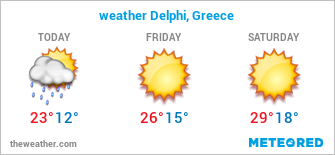
Kleovis and Viton, the Twins of Argos
- the story
These two monumental Archaic marble statues are among the best known examples of the Greek kouros. The twin kouroi dedicated at Delphi are most often identified as the brothers Kleobis and Biton.
Discovered a year apart from each other (in 1893 and 1894) the twin statues and part of one of the inscribed bases were found near the Athenian Treasury; the second base was found reused in a wall of the Roman baths in 1907.

Delphi excavations. Unearthing Kleovis

Delphi excavations. Unearthing Viton
Despite the many similarities they share with other kouroi, several details differentiate these statues and suggest that they are the images of Kleobis and Biton mentioned by Herodotus. They are bulkier and heir burly bodies seem to recall the deed that made them famous by clearly demonstrating their strength and even visually relating them to the oxen that were supposed to bring their mother to the festival. Moreover, unlike most kouroi, these statues are not entirely nude.
They stand side-by-side on separate blocks supported by the same base, which bears part of an inscription. The kouroi are naked except for boots, which distinguish them from images of Apollo and may mark them as travellers. They are stockily built, short though over-life-size, with broad shoulders and broad faces.
The heads are sub-Daedalic, i.e. triangular in form. The round eyes are set within curving upper and lower lids, the entire eye unit cut deeply into the head beneath heavy brows. The mouth is full. The large ears are set far back at the side of the head; the lobe is a flat disk. The transition between the front and sides of the head is very abrupt.

The Kroisos Kouros, in Parian marble, found in Anavyssos (Greece), dating from circa 530 BC, now exhibited at the National Archaeological Museum of Athens.

The bronze Kouros from Delphi
A single row of large disk-like curls line the forehead. The rest of the hair, emphasizing the flat top of the head, is combed and then subdivided into large bead-like elements. In back the hair springs out from beneath the double cord which holds it in place, at the top of the ears and, again, at the base of the neck. Each of the tendrils, front and back, is neatly finished with a tie.
The abdomen is defined linearly. Another line sets off the triangular are of pubic hair above the genitals. The round knees are set off by incision as well as by modeling. The arms are held close to the body, the clenched hands securely attached to the thighs, the thumbs facing outwar
An inscription on the base of Statue A, stating it was made by the sculptor [Poly]medes of Argos, suggests that these were the statues Herodotus saw. A fragmentary inscription on the other base may label that statue as Biton. The inscriptions have been much discussed and a number of readings argued, including a recent attempt to see many new letters which have not been confirmed by other scholars.
Some scholars believe that the inscriptions identify the pair as Castor and Pollux, the divine twins together known as the Dioscuri, rather than Kleobis and Biton. The Dioscuri were well known by the ancient Greeks, who believed they helped young athletes succeed in their competitions. The Dioscuri’s interest in assisting atheletes might make their images especially appropriate dedications at Delphi, which hosted the Pythian Games that attracted competitors from across Greece every four years.
- the myth
Their story is told be Herodotus (Hdt. 1.31), as it was related to Croesus by Solon, who named them as the second most blessed of men.
Herodotus tells us that Kleobis and Biton were the sons of Cydippe, a priestess at the temple of Hera. When their mother's oxen could not be found, the brothers yoked themselves to their mother's cart and pulled their mother 45 stades to the temple of goddess where a festival was held.

-Filial piety of Kleobis and Biton. By Jacques Gamelin. 1764. Musée des Beaux-Arts de Carcassonne, Carcassone, France.
Having accomplished this feat, they feasted, went to sleep in the temple and, at the urging of their mother, were granted the highest honor men may receive — a peaceful death in their sleep. Herodotus then tells us the Argives made and set up images of them in Delphi because of their excellence.





